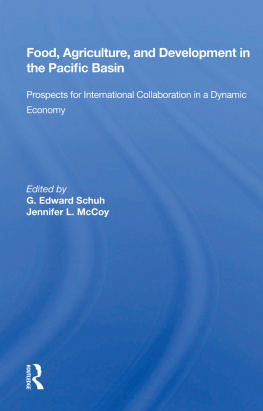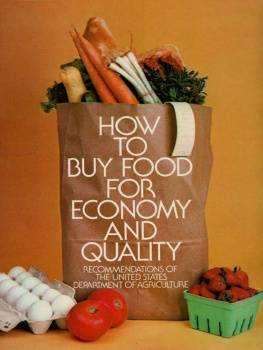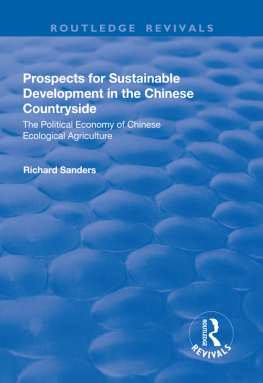Food, Agriculture, and Development in the Pacific Basin
About the Book and Editors
This book is concerned with the management of food production and the distribution of food in the Pacific Basin, exploring food's potential for engendering both increased conflict and cooperation in the region. The authors begin by discussing the role of food and agriculture in the international economy and the implications of two contrasting approaches to food security: international trade and self-sufficiency. They also consider the problem of international migration of labor in the region and look at how agriculture can contribute to the development of the economy in individual countries. The book concludes with a discussion of the prospects for international collaboration in dealing with the domestic and international adjustments required to enhance overall growth and equity in food supply and distribution.
Dr. G. Edward Schuh is director of agriculture and rural development at the World Bank. He is coeditor (with Gale Johnson) of The Role of Markets in the World Food Economy (Westview, 1983). Dr. Jennifer L. McCoy is assistant professor of political science at Georgia State University.
Published in cooperation with
The Hubert H. Humphrey Institute of Public Affairs University of Minnesota, Minneapolis, Minnesota
Pacific Basin Project, Publication #3
Other Titles in This Series
The Management of Pacific Marine Resources: Present Problems and Future Trends, John P. Craven
The Industrial Future of the Pacific Basin, Roger Benjamin and Robert T. Kudrle
Food, Agriculture, and Development in the Pacific Basin
Prospects for International Collaboration in a Dynamic Economy
edited by G. Edward Schuh
and Jennifer L. McCoy
Foreword by Harlan Cleveland
First published 1986 by Westview Press
Published 2018 by Routledge
52 Vanderbilt Avenue, New York, NY 10017
2 Park Square, Milton Park, Abingdon, Oxon OX14 4RN
Routledge is an imprint of the Taylor & Francis Group, an informa business
Copyright 1986 by Hubert H. Humphrey Institute of Public Affairs
All rights reserved. No part of this book may be reprinted or reproduced or utilised in any form or by any electronic, mechanical, or other means, now known or hereafter invented, including photocopying and recording, or in any information storage or retrieval system, without permission in writing from the publishers.
Notice:
Product or corporate names may be trademarks or registered trademarks, and are used only for identification and explanation without intent to infringe.
Library of Congress Cataloging-in-Publication Data
Main entry under title:
Food, agriculture, and development in the Pacific
Basin.
(Pacific basin project; publication 3)
"Published in cooperation with the Hubert H. Humphrey
Institute of Public Affairs, University of Minnesota,
Minneapolis, Minnesota."
Papers resulting from an international workshop
held in June 1982 in Mexico City and sponsored by
Sistema Alimentario Mexicano, a special organization
in the office of the President of Mexico.
Bibliography: p.
Includes index.
1. Food supplyPacific AreaCongresses.
2. AgricultureEconomic aspectsPacific Area
Congresses. I. Schuh, George Edward, 1930
II. McCoy, Jennifer L. III. Hubert H. Humphrey
Institute of Public Affairs. IV. Series.
HD9018.P16F66 1986 338.1'099 86-1301
ISBN 13: 978-0-367-00605-1 (hbk)
Contents
- Part 1
The Setting: Development, Food, and the International Economy - Part 2
International Trade and Self-Sufficiency: Contrasting Approaches to Food Security - Part 3
Case Studies in Domestic Policy and International Trade - Part 4
The International Migration of Labor - Part 5
Technological and Research Capacity, Exchange, and Diffusion - Part 6
Conclusions
- Part 1
The Setting: Development, Food, and the International Economy - Part 2
International Trade and Self-Sufficiency: Contrasting Approaches to Food Security - Part 3
Case Studies in Domestic Policy and International Trade - Part 4
The International Migration of Labor - Part 5
Technological and Research Capacity, Exchange, and Diffusion - Part 6
Conclusions
Guide
In the late 1970s a sudden wave of organizational enthusiasm crested for various projects concerning the Pacific. Japan's Prime Minister (1979-1980) Masayoshi Ohira initially envisioned the concept of a "Pacific Community" and discovered a mutually interested party in Australia's Prime Minister Malcolm Fraser, In fact, Australia sponsored the first in a series of seminars about a Pacific Community of nations. Meanwhile, in the United States, congressional committees compiled reports and held hearings on Ohira's Pacific Community idea.
In the structure of world order the technologically strong are usually the first to demand and establish organization and institutions. The technologically weakthe developing nationscustomarily react with apprehension, fearing that the strong want to freeze their comparative strength. So it was with the Pacific Community. A Korean described the concept as "a prematurely bom child." Voices from ASEAN (the Association of Southeast Asian Nations), protective of their newly valued subregional cooperation, were fiercely cautious about what one of their spokesmen called "promoting a generalized Community."
In the Western Pacific and East Asia, wartime Japan's greater East Asian Co-Prosperity Sphere still lives in memory. Forty years later, another co-prosperity sphere, even if promoted by certifiably democratic politicians in Japan, Australia, and the United States, still evokes too many disturbing overtones. Just now, it seems every U.S., Japanese, or Australian drumbeat for new Pacific-wide political institutions intensifies the polite but firm, passive resistance of the Pacific's "South"ASEAN, the Pacific islands, the Republic of Korea, and the two parts of a still divided China.
Meanwhile, two independent institutes in the United States that are engaged in policy research have remained deeply interested in the future of the Pacificthe Aspen Institute for Humanistic Studies and the University of Minnesota's newly expanded Hubert H. Humphrey Institute of Public Affairs. Together they envisioned a new approach to the Pacific Community, namely, to set aside for the time being the issue of political organization in the Pacific Basin and begin instead with the underlying questions: What concrete problems need to be tackled, what functions need to be performed that might require new forms of international consultation, cooperation, coordination, parallel national action, or common action by concerned communities in the Pacific Basin?
Until there is some consensus about what has to be done and by whom, the questions raised by "Pacific Community" in its generalized form are indeed unanswerable because prematurely political. A political question like "Which countries should be 'members' of a Pacific Community?" can be addressed only in the context of the functional questions: What action is required, and which countries are in a position to do what about it?










